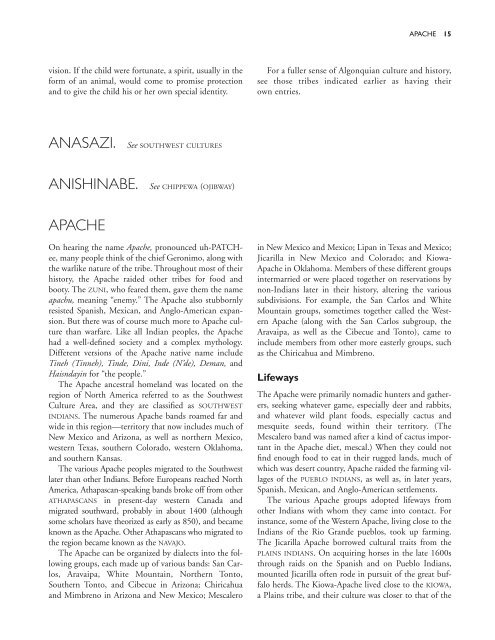Create successful ePaper yourself
Turn your PDF publications into a flip-book with our unique Google optimized e-Paper software.
APACHE 15<br />
vision. If the child were fortunate, a spirit, usually in the<br />
form <strong>of</strong> an animal, would come to promise protection<br />
and to give the child his or her own special identity.<br />
For a fuller sense <strong>of</strong> Algonquian culture and history,<br />
see those tribes indicated earlier as having their<br />
own entries.<br />
ANASAZI. See SOUTHWEST CULTURES<br />
ANISHINABE. See CHIPPEWA (OJIBWAY)<br />
APACHE<br />
On hearing the name Apache, pronounced uh-PATCHee,<br />
many people think <strong>of</strong> the chief Geronimo, along with<br />
the warlike nature <strong>of</strong> the tribe. Throughout most <strong>of</strong> their<br />
history, the Apache raided other tribes for food and<br />
booty. The ZUNI, who feared them, gave them the name<br />
apachu, meaning “enemy.” The Apache also stubbornly<br />
resisted Spanish, Mexican, and Anglo-<strong>American</strong> expansion.<br />
But there was <strong>of</strong> course much more to Apache culture<br />
than warfare. Like all Indian peoples, the Apache<br />
had a well-defined society and a complex mythology.<br />
Different versions <strong>of</strong> the Apache native name include<br />
Tineh (Tinneh), Tinde, Dini, Inde (N’de), Deman, and<br />
Haisndayin for “the people.”<br />
The Apache ancestral homeland was located on the<br />
region <strong>of</strong> North America referred to as the Southwest<br />
Culture Area, and they are classified as SOUTHWEST<br />
INDIANS. The numerous Apache bands roamed far and<br />
wide in this region—territory that now includes much <strong>of</strong><br />
New Mexico and Arizona, as well as northern Mexico,<br />
western Texas, southern Colorado, western Oklahoma,<br />
and southern Kansas.<br />
The various Apache peoples migrated to the Southwest<br />
later than other Indians. Before Europeans reached North<br />
America, Athapascan-speaking bands broke <strong>of</strong>f from other<br />
ATHAPASCANS in present-day western Canada and<br />
migrated southward, probably in about 1400 (although<br />
some scholars have theorized as early as 850), and became<br />
known as the Apache. Other Athapascans who migrated to<br />
the region became known as the NAVAJO.<br />
The Apache can be organized by dialects into the following<br />
groups, each made up <strong>of</strong> various bands: San Carlos,<br />
Aravaipa, White Mountain, Northern Tonto,<br />
Southern Tonto, and Cibecue in Arizona; Chiricahua<br />
and Mimbreno in Arizona and New Mexico; Mescalero<br />
in New Mexico and Mexico; Lipan in Texas and Mexico;<br />
Jicarilla in New Mexico and Colorado; and Kiowa-<br />
Apache in Oklahoma. Members <strong>of</strong> these different groups<br />
intermarried or were placed together on reservations by<br />
non-Indians later in their history, altering the various<br />
subdivisions. For example, the San Carlos and White<br />
Mountain groups, sometimes together called the Western<br />
Apache (along with the San Carlos subgroup, the<br />
Aravaipa, as well as the Cibecue and Tonto), came to<br />
include members from other more easterly groups, such<br />
as the Chiricahua and Mimbreno.<br />
Lifeways<br />
The Apache were primarily nomadic hunters and gatherers,<br />
seeking whatever game, especially deer and rabbits,<br />
and whatever wild plant foods, especially cactus and<br />
mesquite seeds, found within their territory. (The<br />
Mescalero band was named after a kind <strong>of</strong> cactus important<br />
in the Apache diet, mescal.) When they could not<br />
find enough food to eat in their rugged lands, much <strong>of</strong><br />
which was desert country, Apache raided the farming villages<br />
<strong>of</strong> the PUEBLO INDIANS, as well as, in later years,<br />
Spanish, Mexican, and Anglo-<strong>American</strong> settlements.<br />
The various Apache groups adopted lifeways from<br />
other Indians with whom they came into contact. For<br />
instance, some <strong>of</strong> the Western Apache, living close to the<br />
Indians <strong>of</strong> the Rio Grande pueblos, took up farming.<br />
The Jicarilla Apache borrowed cultural traits from the<br />
PLAINS INDIANS. On acquiring horses in the late 1600s<br />
through raids on the Spanish and on Pueblo Indians,<br />
mounted Jicarilla <strong>of</strong>ten rode in pursuit <strong>of</strong> the great buffalo<br />
herds. The Kiowa-Apache lived close to the KIOWA,<br />
a Plains tribe, and their culture was closer to that <strong>of</strong> the


















